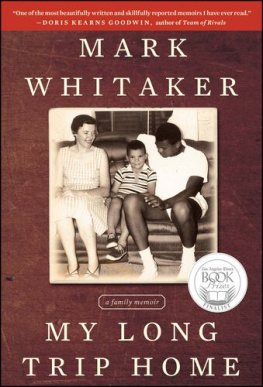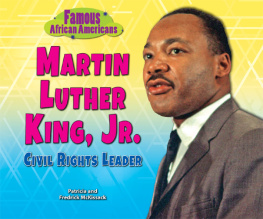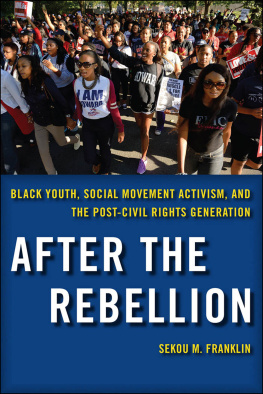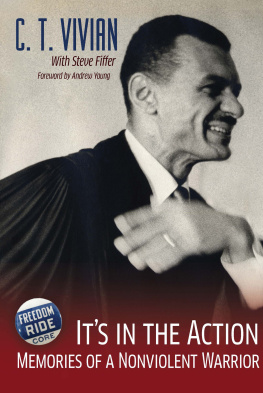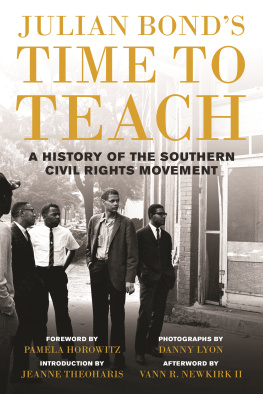This world demands the qualities of youth: not a time of life but a state of mind, a temper of the will, a quality of the imagination, a predominance of courage over timidity, of the appetite for adventure over the love of easeIt is young people who must take the lead.
Prologue
Freedom High
Raleigh, North Carolina, Good Friday 1960
Even now, more than forty years later, Charles McDew can close his eyes and summon a clear memory of Easter weekend 1960the cramped and sweaty auditorium, the worn-out dorm room he bunked in for the weekend, the poor institutional food he ate. He came to join other young African Americans at Shaw University in North Carolina for a summit about the sit-in protests that he and others had begun to conduct at the lunch counters of the South. The result was the founding of the Student Nonviolent Coordinating Committee (SNCC). No one attending could have predicted how much SNCC would contribute to the successes of the civil rights movementor, more simply, the movementhow directly it would take up epoch-making causes like the antiwar protests and the womens movement, how it would end up making history.
It was also the moment when the civil rights movement tapped the energiesthe careless expectations and raw idealismof its own youth, becoming the potent force that would finally topple legal segregation during the next five years. In the wake of the Supreme Courts 1954 decision against segregated schooling in Brown v. Board of Education of Topeka and the 1955 Montgomery bus boycott, a civil rights movement seemed ready to take off. But during the nearly three years following the bus boycotts conclusion in 1956, civil rights activism had sputtered and stalled. The student-led sit-ins revived the movement, harnessing mass protest as an effective weapon, providing every black American with a sense of involvement, reaching into the farthest corners of the South, and tugging at the conscience of the nation.
The sit-ins that swept the South in the winter and spring of 1960 marked the political awakening of the baby boom generation. Many of those at Shaw were born just before World War II, before the boom, but they set the generational tone in terms of rhetoric, style, and ideas. In one way or another baby boomers would shape the politics of the rest of the twentieth century; their values, black and white, were formed in places like Shaw in the early 1960s. This was when they grasped for the first time that the world of their parents was theirs to take, and to remake.
When the leaders of the fledgling sit-in effort arrived at Shaw University, a small, little-known black school, they numbered just a hundred or so, but their cause had swept across the South in the ten weeks since the first sit-in demonstration on February 1. The uncertain leaders of what suddenly seemed like an authentic movement had come to Shaw to share tactics, to refine strategy, to swap stories, and simply to meet one another for the first time.
Charles McDew had no idea where the movement was heading; all he knew was that this was about the most exciting thing he had done in his entire life. Like many of the delegates, McDew had stumbled into political protest. In 1960, he was a nineteen-year-old burly ex-football-playing freshman from Massillon, Ohio, nearing the end of his first year at South Carolina State in Orangeburg. Hed had trouble moving from the relatively liberal world of Massillon to the segregated world of the small-town South. Once during a traffic stop, a local cop demanded that McDew call him sir, asking, They never taught you that up North? When McDew made the mistake of actually answering, the cop responded by smacking him across the face with his nightstick, breaking his jaw.
McDew encountered racism in more intimate ways as well. When none of the local white churches allowed him in to worship during Religious Emphasis Week, he converted to Judaism because the rabbi welcomed him with open arms, and Judaism led McDew into the movement. Shortly after the first sit-ins in North Carolina, he stumbled on the following passage in the Talmud, the Jewish compilation of rabbinical knowledge: If I am not for myself, who will be for me? If I am for myself only, what am I? If not now, when? At that moment McDew realized that the injustices he faced went beyond any personal experience and he had a moral obligation to join the protests. When the Orangeburg students held their first sit-in on February 25, they picked Charles McDew as their leader. In the six weeks since then, more than five hundred students had been arrested, beaten by policemen, drenched with fire hoses in the freezing cold of winter, and jailed in a chicken coop. Though they had not yet succeeded in integrating the lunch counters of Orangeburg, the students did not waver in their commitment.
A year later McDews friend Bob Moses perfectly captured the young activists spirit: McDew, a black by birth, a Jew by choice, and a revolutionary by necessity, has taken the deep hates and loves of America, and the world, reserved for those who dare to stand in a strong sun and cast a sharp shadow. Mosess words revealed the crosscurrents that pulled at the young activists: some things they chose, other things were thrust upon them, but most important was their participation in the movement, the simple choice to stand up and claim their due as American citizens.
Few of the young men and women gathered at Shaw knew then that becoming civil rights activists would define the arc of their lives. Far from being confined to a few dramatic years in the early 1960s, the story of SNCC and the influence of the civil rights generation stretches from World War II to Barack Obamas election. But at Shaw, the young protesters only vaguely understood how the powerful forces of economic development, migration, and youth culture unleashed by World War II had created the conditions that made the sit-ins possible. Nor could they have predicted that SNCC would become for a brief period the center of the civil rights movement, or that their own milestones over the next few yearsfrom the Freedom Rides to Freedom Summerwould define a key passage in American history, or that by the 1970s they would be big-city mayors, members of Congress, organizational leaders, and policy experts who shaped national debate. For what was to remain of the American Century, other baby boomers would measure their own influence against the standard set by SNCC, and SNCC veterans would measure the rest of their lives against the standards they set in their youth.

In April 1960, the movement was fresh and the future unwritten. The students were flush with excitement at the power of the sit-ins, at their sheer newness. The Good Friday air crackled with anticipation as students from all over the South began arriving at Shaw. As one participant recalls: There was no SNCC, no ad hoc committees, no funds, just people who did not know what to expect but who came. As people filtered onto the campus that Friday night to introduce themselves, it was a bit like a revved-up version of the first day of college. Here everyone had already done something brave and fantastic. You began to meet these people from all these different sit-in places, one participant from Atlanta remembers, and you said, Oh yeah, I remember reading about what you all did there. The idea began to seep in that we might be real hell-on-wheels.



